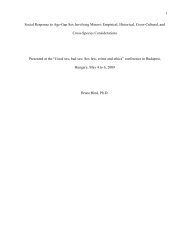Infant and Child Sexuality: A Sociological Perspective - Ipce
Infant and Child Sexuality: A Sociological Perspective - Ipce
Infant and Child Sexuality: A Sociological Perspective - Ipce
Create successful ePaper yourself
Turn your PDF publications into a flip-book with our unique Google optimized e-Paper software.
dependency-affectional <strong>and</strong> sexual behavior patterns as the monkeys grew<br />
older. The human infant, a pliable but non-ambulatory bundle of soft<br />
<strong>and</strong> spongy bony tissue with a resultant uncanny ability to achieve unusual<br />
postures both prenatally as well as after birth, can only interact<br />
with people as they come to him. At a rapid rate, however, the<br />
infant develops the capacity to locomote, thereby facilitating the development<br />
of the ability to be the initiator of encounters with others.<br />
The newborn’s whole body of impulse <strong>and</strong> potential can be viewed as<br />
an undifferentiated potential for physical <strong>and</strong> emotional <strong>and</strong> social experience.<br />
(Comfort, 1963).<br />
Sexual-erotic development, as all development, takes place at different<br />
rates <strong>and</strong> in different ways in different individuals; development<br />
in the affectional-sexual-erotic area is not separable from<br />
development in other areas. As an infant develops, every aspect of his<br />
life experience is capable of affecting every other part. This is markedly<br />
evident in the case of the infant whose motor development has progressed<br />
to the stage where he no longer must await, but can actively<br />
seek encounters with others, whether they be an infant running to hug<br />
daddy hello or an infant opening his arms as an indication of his desire<br />
to be held.<br />
The earliest encounters of infant <strong>and</strong> mother can hardly help but<br />
contribute to the sensory <strong>and</strong> affectional awakening of the infant<br />
arousing sensitivity in his body <strong>and</strong> stimulating the growth of sexual<br />
consciousness. Evidence of a child’s capacity for sensory pleasure in<br />
the first year of life is apparent. From birth to one year of age the<br />
mouth is the chief pleasure zone of the infant, but he responds to total<br />
body contact as well. (Renshaw, 1971). The chief pleasurable activity<br />
in the first year is sucking at the mother’s breast or thumb<br />
sucking. However, the progressive development <strong>and</strong> orderly shift of sexuality<br />
from the mouth to other parts of the body (feet, thighs, abdomen)<br />
is evidenced in the activities of the infant when he is naked or<br />
when being bathed. His fingers w<strong>and</strong>er searchingly over other parts of<br />
his body exploring the ears, the navel, the nipple region, <strong>and</strong> the genital<br />
area. Whether the infant is free to explore <strong>and</strong> stimulate his own<br />
body depends largely upon the parental acceptance of the infant’s nakedness<br />
<strong>and</strong> freedom of bodily activities.<br />
Even prenatally, as we have already indicated, the human begins to<br />
develop a system of tensional outlets. These include changing positions<br />
in the womb, pre-sleep rocking in the crib, bedshaking, head<br />
banging, as well as h<strong>and</strong>ling of the genitals <strong>and</strong> possibly some masturbating.<br />
Removal of clothes <strong>and</strong> attempts to run around naked occur between<br />
one <strong>and</strong> two years. (Ilg <strong>and</strong> Ames, 1955). By two years the infant<br />
has already incorporated some of these impulses into forms of expression<br />
permitted by society, <strong>and</strong> although rocking, head banging, <strong>and</strong> some<br />
masturbating occur (Gesell <strong>and</strong> Ilg, 1946, p. 271), much of the two year<br />
old’s release of tension is manifested by displays of strong affection<br />
toward parents--kissing, for example. (Gesell <strong>and</strong> Ilg, 1946, p. 322).<br />
Dolls <strong>and</strong> teddy bears receive much attention as well. Feeding, toileting,<br />
dressing, <strong>and</strong> being taken for rides is characteristic of things<br />
that occupy the two year old’s attention. (Gesell <strong>and</strong> Ilg, 1946, p.<br />
366). The evidence of underlying sexual development is exhibited in<br />
other achievements of the infant. Naming of the genitals with the use<br />
of a word for urination, distinguishing boys from girls on the basis of<br />
clothing <strong>and</strong> haircut (rather than on the basis of bodily differences),<br />
5
















